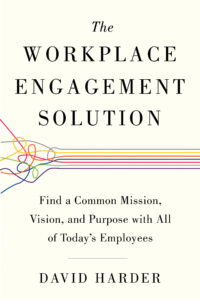Find a Common Mission, Vision and Purpose
Despite billions of dollars of investments, organizations around the globe see employee engagement stagnant at only 13%.
David Harder, author of The Workplace Engagement Solution: Find a Common Mission, Vision, and Purpose With All of Today’s Employees, believes that CEO’s can successfully awaken the culture, and that you can create an enthusiastic culture and loyal customers. David is the founder of Inspired Work. Over 42,000 participants have engaged in his program to change careers, become better leaders, and launch businesses.
I asked him about his engagement ideas.
What are some of the characteristics of a culture that it truly “engaged”?
An engaged culture promotes continuous learning so that employees are not only growing, they are staying ahead of change. Even better, they are bringing positive change into the organization.
An engaged CEO or business owner leads an engaged culture. If she or he is disengaged from the culture, the employee population will also be disengaged.
An engaged culture recognizes that everyone walks in the door with various sets of life skills. Therefore, the organization makes sure everyone has the necessary life skills to change and engage. These include sales, presentations skills, the ability to influence, and clarity in how to build a vitally effective support system.
Self-reflection is encouraged in a strongly engaged culture. At Cornerstone on Demand, executives routinely ask questions such as, “What’s your next move?” “Where are you going next?” After seven years employees are given a sabbatical for self-reflection. The point is, we cannot have engagement without a connection to one’s own truth. We have proven this thousands of times in our programs, which are question driven.
I’ve featured many people on this site talking about the problem of engagement. The stats are remarkable. We didn’t have sophisticated surveys years ago. Do you think this is a new phenomenon?
In the scheme of things, surveys are a bit old-school. The problem with surveys is they don’t produce change. Unless there is a solid commitment to produce an engaged culture, they often create more harm than good.
My point in The Workplace Engagement Solution: Find a Common Mission, Vision, and Purpose With All of Today’s Employees is that the majority of workers are checked-out, to various degrees. Getting them back requires a visionary commitment from the leadership but it also requires that we teach people how to change and engage. Notice that I rarely use one work without the other. Right now, according to a recent New York Times study, 48% of Americans view themselves as “underemployed.” This is also a staggering number and yet it is reflective of workers at odds with keeping up with change.
The Importance of Mission
Mission, vision, and purpose. Talk about their importance.
The moment mission, vision, and purpose becomes a make or break venture is when everything falls apart. Without a clear sense of mission, vision, and purpose, we stop what we are doing. Why is this so important with all workers? If someone doesn’t have a clear answer to “why am I doing this?” that is stronger than simply having a job, we have disengagement.
What ways help make the organizational mission, vision and purpose real throughout the organization and not just a a PowerPoint slide?
A PowerPoint slide is one of the sure ways to produce disengagement!
One of the reasons across-the-board mentorship is so important is that one-on-one conversations can be doors to shared vision. Sure, an organizational vision is important but a personal vision is critically important as well. Inspired Work opened in 1990 with a two-day seminar for the public. Organizations were afraid to give that program to all their workers. Good Lord, if we get everyone to tell the truth they will all leave. The results are vastly different. When we get employees to define and express their vision, it opens the door for a collaborative vision. Common sense would only demonstrate this is what we have to do.
Here is an example: Adobe recently and famously did away with performance reviews. Many other organizations are following suit. It turns out that many managers stop communicating when they know a big cumbersome review comes up once a year. Now, they are encouraging ongoing dialogue, so managers are more aware of what their direct reports want to accomplish.
What role does leadership development play in improving organizational culture?
Leadership is a critical link in the engagement equation. However, far too many consultants, damn the leadership for every engagement shortcoming. In The Workplace Engagement Solution, everyone is equally responsible. We cannot have engagement without an engaged CEO. But, engagement falls apart if we are ignoring the produce manager who tells off customers because he doesn’t want to be bothered with questions.
You speak to middle managers towards the end of the book, a group many ignore. What’s your message to middle management?
This is the problem! Many mid-managers are ignored. As per the answer to your previous question, if we are damning executive leaders for culture and charging big fees to improve their skills, what about the mid-manager who is overworked, frenzied, and often quite bitter? This elitist approach to talent development is misguided. Almost 90% of America’s customer service workers are “led” by mid-managers. The results can be personally witnessed by going into virtually any big store and asking for help.
Build a Mentor-Driven Culture
What’s a mentor-driven culture and how do you best build one?
Let’s begin by not making it an elitist kind of function. One of the reasons I used 12-step programs such as Alcoholics Anonymous as a wonderful example of mentorship is we turn early-adopters of the skills into mentors. In an organization, anyone who develops the skills to change oneself, to connect with others, to learn continuously, and to engage with the world can become a mentor. This kind of model opens the door to a highly cost-effective way to build talent within an organization. It also can elevate the culture into one that is deeply caring without sacrificing performance standards. In fact, a good mentoring experience raises performance standards. For example, a mentor can say, “Listen, it isn’t enough to come into my office and proclaim you are going to build a better customer service experience. I want to hear how you are going to become a better person because of that or what it is that you want out of doing that.” A good mentor can tell an employee they are becoming obsolete because they are not learning the skills to grow because they are afraid. A good mentor program can become the place that supports positive risk-taking throughout an organization.
For more information, see The Workplace Engagement Solution: Find a Common Mission, Vision, and Purpose With All of Today’s Employees.

